 I really like the .243 Winchester cartridge. In fact, when I got to the handloading portion of this project I found that I had: three sets of dies, including small base, three headspace gauges, sixty types and weights of 0.243″ bullets, and four rifles in bolt and lever action, with barrel lengths from 18½” – 24″.
I really like the .243 Winchester cartridge. In fact, when I got to the handloading portion of this project I found that I had: three sets of dies, including small base, three headspace gauges, sixty types and weights of 0.243″ bullets, and four rifles in bolt and lever action, with barrel lengths from 18½” – 24″.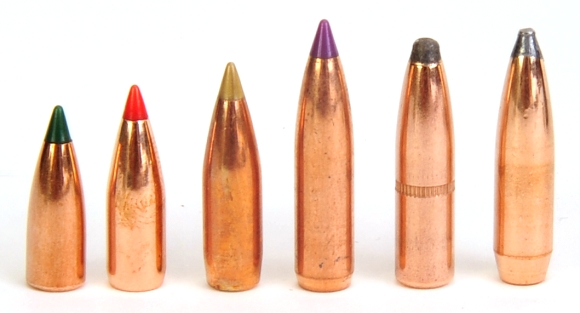
| .243 Caliber Bullet Selection | |||||
|---|---|---|---|---|---|
| Brand | Type | Weight | Length | B.C. | Application |
| Sierra | BlitzKing | 55 | 0.750 | 0.264 | Varmint |
| Hornady | V-Max | 65 | 0.835 | 0.280 | Varmint |
| Remington | AccuTip V | 75 | 0.935 | 0.325 | Varmint |
| Nosler | Ballistic Tip | 95 | 1.112 | 0.379 | Antelope – Deer |
| Prvi Partizan | Soft Point | 100 | 1.015 | 0.320 | Antelope – Deer |
| Speer | Boat Tail Soft Point | 100 | 1.050 | 0.430 | Antelope – Deer |
Notable? Hmmm… only one bullet has a cannelure, which is fine as neck tension alone should do the trick for anyone who isn’t prone to tripping and falling on his or her cartridges in the field. The boat tail bullets are of particular interest as they will not be more accurate, nor will they perform better ballistically within the hunting ranges I would experience (the south side of 300 yards). However, they are impressive in appearance and the deer just love ’em. The pictures of Prvi and Speer bullets are good examples of why bullets should have plastic tips. Just this level of deformation effects ballistic coefficient in a meaningful way and give erroneous seating depth indications if measuring cartridges end to end with calipers.

Handloading and firearm knowledge is a lot like playing the game “Telephone”. No, not that one. I mean the one where you get a group of people, the first whispers a phrase to the person next to them, that person whispers their understanding of what they heard to the next, until what went in as “Jessica Simpson has big feet” comes out as “My goat is with cheese”. Sometimes you have to go back and check in with the goat. My opinion of Nosler’s Ballistic Tip bullet was based mostly on my experience with pushing a 200 grain version to nine million miles per hour from the mouth of a .338-378 Weatherby Magnum into a block of cement. The bullet did not fare too well. My conclusion wasthat the bullet is not useful on large thin skinned game… the earth is flat and Columbus discovered Ohio. Fortunately, as all things related to firearms are in a constant state of flux, I have enough integrity to know I can occasionally be a dumb ass, so I reopen cold case investigations and stop navigating from the bridge of a misguided ship called Conjecture.
Pictured above, the light 55 grain Sierra BlizKing with a very thin heel and uniformly thin jacket seems poised to earn its name. The 65 Hornady V-Max is an interesting combination of controlled expansion shank and heel, but with a thin nose, large cavity and a plastic insert intended to blow the nose open on impact. Gesundheit! The 95 grain Ballistic Tip is actually quite stout from the thick heel jacket to the thick shank jacket to the relatively heavily jacketed nose. In fact, it is a much more durable projectile than the 100 grain Speer parked right next to it, an exceptional bullet in its own right. So I will no longer voice a Ballistic Tip condemnation… or call for a Con-gres-sional in-ves-tigation… per-taining to my prior al-le-gation. Sorry, the UPS guy was listening to rap music when he came into the office. Where was I? Oh yeah…
The factory baseline motivator… Superformance
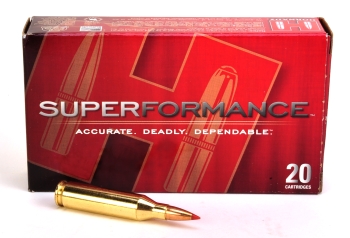
Hornady has brought some harsh realities to handloading. For anything I’ve tried in this brand, velocity was always greater than I could attain working with available powders and safe pressure levels. Oh, I can outperform Superformance in any rifle, but only once per rifle. Superformance ammo has made me a better handloader in that “better” can’t always mean higher velocity, so the emphasis is shifted to making handloads more accurate and with a broader combination of components.
Superformance was added to the assessment of the Ruger M77 International for the same reason I added it to the .308 Winchester rifles I’ve built and/or tested of late. The ammunition has a way of bringing significantly higher levels of performance to short barrel guns or low capacity cartridges. In doing do, Superformance opens up a whole new selection of firearms that meet performance standards not attainable with standard ammunition or handloads. It put the .308 Winchester cartridge on par with high performance 30-06 Springfield handloads and I thought it might make up for the .243 Winchester cartridge being fired from the shorter 18.5″ barrel Ruger. The 80 grain GMX loads are rated at 3,425 fps muzzle velocity, approximately 75 fps faster than performance loads from Remington and Winchester.
Handloads… Stout Handloads
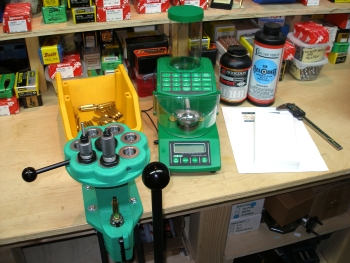 All handloads were assembled from Remington 3X used brass; cleaned, full length sized, trimmed and chamfered to 2.035″, and cleaned again. No sorting by weight was done. Reloading dies were RCBS. Primers in all loads were CCI 200 large rifle.
All handloads were assembled from Remington 3X used brass; cleaned, full length sized, trimmed and chamfered to 2.035″, and cleaned again. No sorting by weight was done. Reloading dies were RCBS. Primers in all loads were CCI 200 large rifle.
Hornady’s 100 grain bullet was added. Selected to hedge the use of the Speer with its somewhat more fragile jacket. COL was juggled to make sure all came in under COL maximum, but also to come as close to 100% case fill with the powders selected. The approach, at least based on empirical data, helps accuracy.
Sometimes it is necessary to work powder selection more thoroughly for a short barrel gun; maybe powder a little quicker than typical. In this case I actually stayed on the relatively slow powder side and brought in a gun with a 22″ barrel to track how much, specifically, was given up for the convenience of a compact rifle.
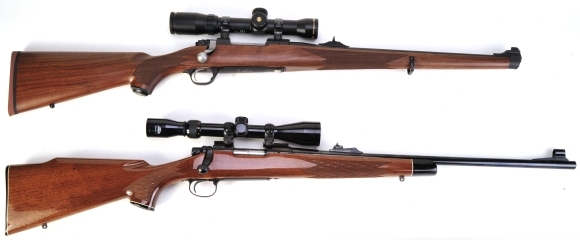
| Manufacturer | Type | Weight Grains |
Net H2O Capacity |
COL | Primer | Powder | Charge | MV 18.5″ |
MV 22″ |
Δ fps |
ME 18.5″ |
ME 22″ |
Δ ft/lbs |
| Sierra | BlitzKing | 55 | 52.1 | 2.630 | LR | Varget | 45.5 | 3614 | 3769 | 155 | 1595 | 1735 | 140 |
| Hornady | V-Max | 65 | 50.8 | 2.600 | LR | Varget | 43.5 | 3534 | 3651 | 117 | 1803 | 1924 | 121 |
| Remington | AccuTipV | 75 | 49.8 | 2.616 | LR | Varget | 42.0 | 3330 | 3433 | 103 | 1847 | 1963 | 116 |
| Nosler | Ballistic Tip | 95 | 48.7 | 2.700 | LR | Re 19 | 45.5 | 3069 | 3114 | 45 | 1987 | 2046 | 59 |
| Prvi Partizan | Soft Point | 100 | 49.7 | 2.650 | LR | Re 19 | 45.5 | 2959 | 3095 | 136 | 1945 | 2128 | 183 |
| Speer | BTSP | 100 | 49.6 | 2.700 | LR | Re 19 | 46.0 | 3037 | 3168 | 131 | 2049 | 2229 | 180 |
| Hornady | BTSP | 100 | 48.5 | 2.625 | LR | Re 19 | 45.0 | 3033 | 3159 | 126 | 2043 | 2216 | 173 |
| Hornady | GMX | 85 | Superformance Factory Ammo | 3131 | 3291 | 160 | 1851 | 2045 | 194 | ||||
The short barrel gun turned in impressive velocity readings. Certainly fast enough to not jump for a 22″ gun to overcome the practical disparity between the 18½” and 22″ performance. From a trajectory standpoint the Speer load, with a 200 yard zero experienced 0.6″ greater drop with the 18½” barrel than the 22″ barrel; a negligible difference.
From an accuracy standpoint, there was no repeatable difference at 100 yards. The Remington M700, a firearm with some miles on it, shot 1¼” – 1½” as a general rule. The International shot an inch or better, at times substantially better. The best group for the International came with the 100 grain Speer load, approximately 5/8″ the Remington favored the Hornady 100 grain, just under 1½.” I liked the smallish scope. Big bright optics in a relatively small and light weight scope fit the M77 correctly and had more than enough power for any reasonable range.
Conclusion
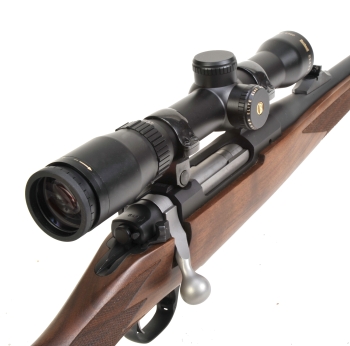
I shoot a lot of rifles, however, as time goes by I have become more selective in the rifles I purchase. I like to have a specific purpose and the intention of owning the gun for a very long time. I’m going to try to get my sons together for a hog hunt this summer. Maybe it will prove to be a good time for my eldest grandson to get in on a first hunt. The Ruger would probably be just about right for him.
An under seven pound gun with a ton of muzzle energy but only twelve pounds of recoil. An 18½” barrel and 38″ in overall length, but still over 3,000 fps of muzzle velocity and only 6″ of drop at 300 yards on a 200 yard zero. Very nice gun, traditional, well made, excellent shooter. Ruger’s M77 Mark II International

Email Notification